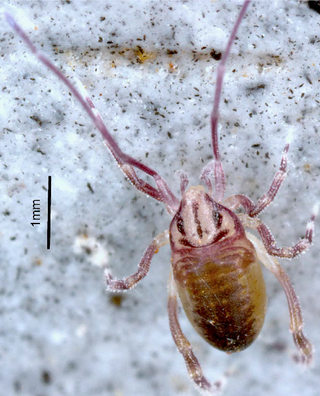
Myxophaga is the second-smallest suborder of the Coleoptera after Archostemata, consisting of roughly 65 species of small to minute beetles in four families. The members of this suborder are aquatic and semiaquatic, and feed on algae.

Parasitiformes are a superorder of Arachnids, constituting one of the two major groups of mites, alongside Acariformes. Parasitiformes has, at times, been classified at the rank of order or suborder.

Opilioacaridae is the sole family of mites in the order Opilioacarida, made up of about 13 genera. The mites of this family are rare, large mites, and are widely considered primitive, as they retain six pairs of eyes, and abdominal segmentation. They have historically been considered separate from other mites belonging to Acariformes and Parasitiformes, but are now generally considered a subgroup of Parasitiformes based on molecular phylogenetics.

Anaxyelidae is a family of incense cedar wood wasps in the order Hymenoptera. It contains only one living genus, Syntexis, which has only a single species, native to Western North America. Fossils of the family extend back to the Middle Jurassic, belonging to over a dozen extinct genera, with a particularly high diversity during the Early Cretaceous. Syntexis lay eggs in the sapwood of conifers, preferring recently burnt wood.

Trigonalidae is one of the more unusual families of hymenopteran insects, of indeterminate affinity within the suborder Apocrita, and presently placed in a unique superfamily, Trigonaloidea, and the only extant taxon in the superfamily. The other putative related taxon is the extinct family Maimetshidae, known from the Cretaceous period. Trigonalidae are divided into 2 subfamilies; Orthogonalinae and Trigonalinae. These wasps are extremely rare, but surprisingly diverse, with over 90 species in 16 genera, and are known from all parts of the world. It is possibly the sister group to all Aculeata.

Psocomorpha is a suborder of barklice, booklice, and parasitic lice in the order Psocodea. There are more than 20 families and 5,300 described species in Psocomorpha.

Mesostigmata is an order of mites belonging to the Parasitiformes. They are by far the largest group of Parasitiformes, with over 8,000 species in 130 families. Mesostigmata includes parasitic as well as free-living and predatory forms. They can be recognized by the single pair of spiracles positioned laterally on the body.

Spirostreptida is an order of long, cylindrical millipedes. There are approximately 1000 described species, making Spirostreptida the third largest order of millipedes after Polydesmida and Chordeumatida.

The Laelapidae are a family of mites in the order Mesostigmata. The family is also referred to in the literature as Laelaptidae, which may be the correct spelling.
Ologamasidae is a family of mites in the order Mesostigmata. There are more than 40 genera and 470 described species in Ologamasidae.

Pachylaelapidae is a family of mites in the order Mesostigmata. There are about 16 genera and more than 200 described species in Pachylaelapidae.
The family Ameroseiidae is one of the three families of mites under the superfamily Ascoidea. There are about 12 genera and more than 130 described species in Ameroseiidae. The family has a worldwide distribution.
Ascidae is a family of mites in the order Mesostigmata.

Rhinonyssidae is a family of mites in the order Mesostigmata. There are about 16 genera and at least 460 described species in Rhinonyssidae.
Sejidae is a family of mites in the order Mesostigmata. The oldest known record of the group is an indeterminate deutonymph from the mid Cretaceous (Albian-Cenomanian) aged Burmese amber of Myanmar.

Caeculidae, also known as rake-legged mites, is a family of mites in the order Trombidiformes, the only family of the superfamily Caeculoidea. There are about 9 genera and about 100 described species in Caeculidae which occur world-wide. The oldest records of the family are from the Cenomanian aged Burmese amber, belonging to the extant genus Procaeculus.

Antennophorina is a suborder of mites in the order Mesostigmata. There are at least 4 families and more than 20 described species in Antennophorina.

Enarthronota is a suborder of mites in the order Oribatida. There are about 14 families and more than 450 described species in Enarthronota.
Burmese amber is fossil resin dating to the early Late Cretaceous Cenomanian age recovered from deposits in the Hukawng Valley of northern Myanmar. It is known for being one of the most diverse Cretaceous age amber paleobiotas, containing rich arthropod fossils, along with uncommon vertebrate fossils and even rare marine inclusions. A mostly complete list of all taxa described up until 2018 can be found in Ross 2018; its supplement Ross 2019b covers most of 2019.

Trigynaspida is a suborder of mites in the order Mesostigmata. There are more than 25 families and at least 90 described species in Trigynaspida.















